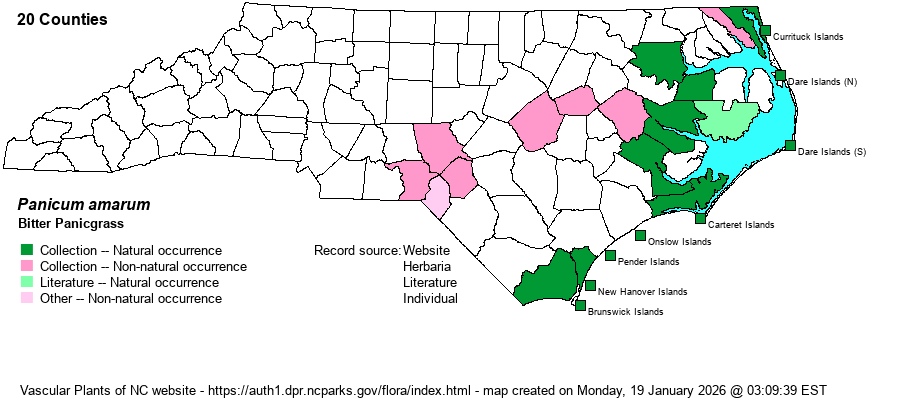| Author | Elliott | |
| Distribution | Outer Banks/barrier islands and outermost Coastal Plain (including Tidewater counties); inland records are either deliberately planted (Sandhills Game Land in Richmond and Scotland counties) or established from plantings somewhere in the vicinity (Moore and Hoke counties).
Maritime, southeastern MA to southern FL and southern TX; northeastern Mex. | |
| Abundance | Frequent to common on the Outer Banks and other barrier islands; uncommon on the outer Coastal Plain. Owing to its abundance in the coastal area, the website editors suggest a State Rank of S4 instead of S3. | |
| Habitat | Maritime dry grasslands, dunes, storm overwash fans, roadsides. Inland records are from railroad margins and roadsides. Planted extensively at the Sandhills Game Land (Richmond and Scotland counties) to provide cover and food in areas lacking Carolina Wiregrass (Aristida stricta), and spreading along roadsides and clearings. |
| Phenology | Flowering and fruiting July-October. | |
| Identification | Bitter Panicgrass grows to 6 or even 7 feet tall and is glaucescent (pale green to blue-green). The inflorescence normally grows 1 to 1.5 feet long, with arching branches; sometimes the whole inflorescence arches. The spikelets are 4-7.7 mm long and taper to a sharp point. This is a tall and frequently seen grass of dunes and sand flats, though not as easily recognized as is Sea Oats (Uniola paniculata). | |
| Taxonomic Comments | We include subspecies (or variety) amarulum here, as differences are minor and it occurs in identical habitats.
The genus Panicum in the broad sense was once very large, but with the split of Dichanthelium in the 1980s, it has been reduced to manageable size. In more recent decades, other genera have been split off: Coleataenia, Hymenachne, Kellochloa, and Phanopyrum, as examples. All 6 of these genera can be readily told from each other in the field with just a hand lens. For a more detailed discussion, see the introductory paragraphs in Weakley (2018). | |
| Other Common Name(s) | Bitter Panicum, Coastal Panicgrass | |
| State Rank | S3 [S4] | |
| Global Rank | G5 | |
| State Status | | |
| US Status | | |
| USACE-agcp | FAC link |
| USACE-emp | FACU link |

